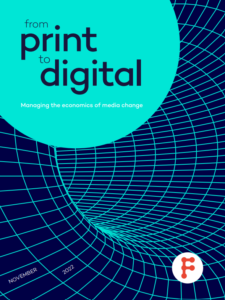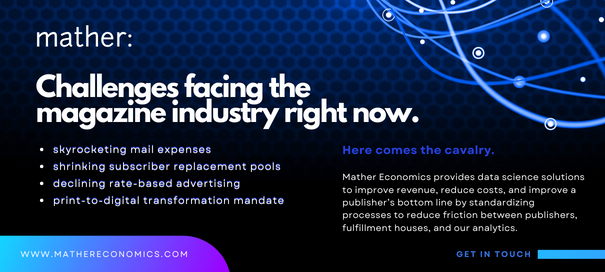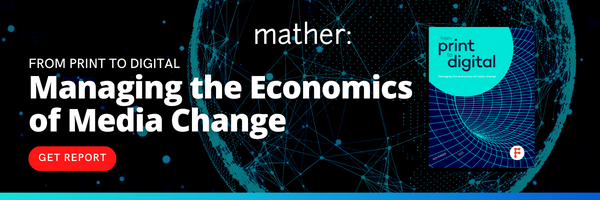DOWNLOAD THE REPORT
From Print to Digital: Managing the Economics of Media Change provides an introduction to the theory of managing the economics of change along with some practical examples of how this process can be implemented day-to-day.
“Agility is probably the most important thing that management team can have now in the media business,” James Hewes, President and CEO of FIPP points out in the report. “There are no sacred cows – you can’t say that this is the way we do things.
“Balancing the old and the new, the existing and the potential, is a really important feature of management. The classic example in the media business is the difference between print and digital. Your print business is going to be declining in most of its revenue streams – you might have had a bounce with the print subscriptions during the pandemic, but in general, your business is going to be declining.
So, what do you do? You manage that business for value, you manage it for profit. Your digital business are going to be growing, or they should be growing, so you manage them for growth. You take the profits from legacy business and invest those into the new areas.”
Keep reading From Print to Digital: Managing the Economics of Media Change.

The latest Managing the Economics of Media Change Report also shares 5 ways to tune up the engine and optimize your subscription strategy
- Swap gut feel for science: Two of the biggest challenges facing publishers today are working out what content should go behind a paywall and finding a way of balancing advertising and subscription revenue based on audience engagement, propensity to subscribe and user value. The solution? Using data science to dynamically set paywalls and subscriber-only content.
- Re-examine your audience funnel: The old sales/marketing/purchase funnel remains a useful visual today. It simultaneously shows the pathway to conversion, while reminding us that while the traditional customer journey from brand awareness to transaction is made, our audience may become smaller, but also more valuable. The same set of visuals can be used to conceptualize today’s subscriptions management process, as we move from growing our audience, to engaging users, through converting them to subscribers, and ultimately managing these relationships to create value on both sides.
- Keep a performance scorecard: A key part to success is measuring performance against the median, best-in-class or comparable peers to determine your maturity as a publisher. In this context, your individual score can be calculated based on the difference between these figures. In its recent Digital Audience Benchmarking Report, below, Mather dives into this process even further, with the assignment of specific metrics to specific stages. At the growth stage your acquisition strategy comes back into play, analyzing exactly where audiences are coming from.
- Migrate or die: It’s a useful reminder of just how beneficial the digital option can be. ‘Stop saves’ are a great way to retain your existing readership, albeit at a reduced rate. If somebody has been paying $32.95 per month for the ‘All Access’ option, and wishes to cancel, then it’s obviously easier to derive a $9.87 PCM subscription from that user than to sign a new one up from scratch. Get the latest pricing tips from Mather’s Pricing Strategy Guide

- Understand the value of your content: Of course, all of these actions will be of complete irrelevance, if the content isn’t there in the first place. It’s no secret that for legacy brands this will be less of a consideration, because they already know that, whether in print or digital, there is an audience out there for their content. But in fact, publishers of all shapes and sizes can, and are finding new and innovative ways to package up their content to make it more appealing. Watch Optimize and Monetize your Digital Content Strategy here

Connect with a Mather Economics team member to
help measure your performance against best-in-class media organizations.

Go to Premium Content Case Study 
Mather Economics predictions and latest Benchmarking Reports


